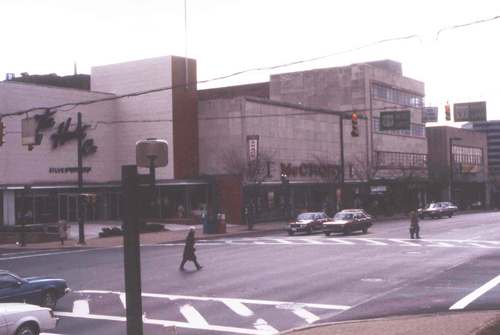Crosswalks: Is it time for a rethink?

Photo by Spacing Magazine on Flickr.
Montgomery County’s built environment runs the gamut from urban to rural, but we take a one size fits all approach to crosswalks. Maybe it’s time for that to change. Bringing the pedestrian scramble back to MoCo will improve our urban areas.
Part of what we are trying to accomplish with our visions for communities throughout MoCo is a blend of the best urban, suburban and rural environments. Over the past three years, the County Council has been bold in adopting plans that work toward creating an active, sustainable MoCo.
The key is implementation of those new visions.
Consider our pedestrian environment in places like downtown Silver Spring and along Rockville Pike, where redevelopment continues to change the street environment, generating more activity. In downtown Silver Spring, the latest significant change is the pending opening of the Live Nation entertainment venue on Colesville Road.
Let’s fast-forward past the opening and imagine the streetscape after a concert ends. Hundreds of patrons spilling out onto Colesville, making their way to cars, Metro, or crossing the street to head into the downtown or hopefully, Fenton Village south of Wayne for an after-concert bite or beverage. (Yes, there is nightlife in Fenton Village — two of my favorites are Jackie’s and the Quarry House.)
The concert-goers have two intersections they might cross: Colesville and Georgia or Colesville and Fenton. Both have recently been redone (one of them twice), and the result is the usual type of crosswalks.
But let’s consider a different type of crosswalk. Something new (but actually old) that engages the pedestrian, giving him or her priority over the cars. Consider an intersection that actually makes the pedestrian feel secure. One that reduces apprehension about crossing a downtown street, where most of the cars are intent on just getting through the intersection to get somewhere else.
Should this be our priority? Helping cars move through our downtowns faster so they can get somewhere else? Or should we be focused on the people who want to stop, visit, patronize our businesses or enjoy our markets, events or meet friends? Can we do both?
Believe it or not, the Fenton/Colesville intersection was once just like the intersections that are all the rage in cities like London, where pedestrian traffic and motor car interactions are in constant conflict. This intersection was a “scramble intersection.” When the light went red for cars, it went red in all directions. Then it was the people’s turn to take priority to move through the intersection. You could walk in any direction in crossing. You could walk at 90 degrees, or even 45 degrees, to avoid crossing to the other side, then again to get to the opposite corner.

The Fenton/Colesville scramble intersection circa 1984. A lonely place, but much safer for pedestrians. Today, the intersection is a bustling downtown intersection that could benefit from bringing back a well-designed scramble crossing.
Implementing a scramble is about a shift in priority from autocentric to pedestrian- and bike-centric movement. It’s a simple and very efficient way of moving people and cars, and we used to do it.
This approach can work in many places here. Think about Rockville Pike a few years from now when the White Flint plan begins to become reality. We could create a pedestrian environment shared equally with cars.
Consider the many intersections in MoCo where this approach could be beneficial for people walking, in wheelchairs, on bikes, as well as in cars.
We are working on some designs in downtown Silver Spring, close to our offices, like at Fenton and Colesville, where this approach makes a lot of sense. If we could transform one or two intersections into a great multi-use intersection, maybe we could resurrect the model that MoCo had at one intersection so many years ago.
Imagine that Live Nation event emptying out onto Colesville, where hundreds of patrons will safely move south into the downtown. Beyond the post-event traffic, the hundreds of people who cross this intersection every day could do so safely, without the apprehension of conflicts with turning vehicles, cars running red lights, or crossing the street twice to get to the opposing corner.
This solution doesn’t cost a lot. In fact, it makes the curb design simpler and only requires some changes to signals. And it removes street clutter. As we complete these designs, we will try to build a constituency to implement these at strategic intersections around the county.
This intersection above is at one of the busiest intersections in downtown Toronto. Where not only motor cars, but the subway and streetcar lines all converge. Count the streetcars moving through the intersection. Watch the crowds crossing in all directions then the cars. Unseen is the subway below. At any point in the day there are huge crossings of people and all types of vehicles.
The County is moving forward with some exciting new strategies for infill growth. We can bring our infrastructure along to help us realize the visions expressed in our plans for major intersections in places like Takoma/Langley, Long Branch, White Flint, and in our busy downtown areas. It is time to rethink how we do pedestrian infrastructure to complement our planning visions.
Crossposted at the Director’s Blog.
